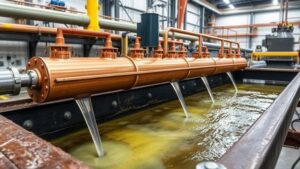How Agricola’s Smelting Techniques Improved Metal Purity
How Agricola’s Smelting Techniques Improved Metal Purity
Georg Agricola, a 16th-century German scholar, is often referred to as the father of mineralogy for his foundational work, De re metallica. His comprehensive examination of mining and metalworking practices transformed the understanding of metallurgy during the Renaissance. This article explores how Agricola’s innovations in smelting techniques contributed to enhanced metal purity, consequently influencing the field of metallurgy significantly.
The Basics of Smelting
Smelting is the process of extracting a metal from its ore through the application of heat and chemical reduction. Agricola recognized that the purity of the resulting metal depended greatly on the smelting techniques used. Prior to Agricola’s advancements, smelting often resulted in metals with significant impurities, which could compromise their usability and quality.
Innovative Furnace Designs
Agricola introduced design improvements to furnaces that were essential in achieving higher temperatures and better control over the smelting process. The use of the “blast furnace,” which allowed for the introduction of air into the furnace to promote combustion, is one of his notable contributions.
- The blast furnace could reach temperatures exceeding 1,600 degrees Celsius, which is critical for reducing metal ores effectively.
- This high temperature facilitated the separation of metal from its ore with greater precision, leading to purer metals.
For example, in the smelting of iron, Agricola’s techniques allowed for a reduction of impurities such as sulfur and phosphorus, which are commonly found in iron ores. The result was a higher quality of wrought iron, which was essential for tools and weapons during that period.
Use of Fluxes in the Smelting Process
Agricola also promoted the use of fluxes–materials added to ores to promote melting and to remove impurities effectively. Common fluxes included limestone and soda ash. These substances combine with impurities to form a molten slag that could be easily removed.
- By employing fluxing agents, Agricola was able to decrease the levels of unwanted elements, thus improving the quality of the metal extracted.
- This process is akin to how certain ingredients in cooking combine to enhance the flavor of a dish, effectively making the final product more palatable.
Refining Techniques Post-Smelt
Post-smelting refining techniques were critical in Agricolas approach to achieving metal purity. He emphasized methods such as cupellation–a process where ore or alloy is treated under high temperatures and controlled operations to separate noble metals from impurities. This technique proved particularly effective for silver and gold.
For example, during cupellation, molten lead absorbs other metals during its oxiding reaction, allowing pure silver to be left behind. Agricolas detailed accounts of this process laid the groundwork for further advancements in metal purification.
The Impact of Agricola’s Techniques
The smelting techniques developed by Agricola had profound implications not just for metallurgy but for various industries reliant on metals. Enhanced purity of metals contributed to stronger alloys, leading to improved performance in tools, weapons, and industrial applications. His methods were foundational for the later development of chemical metallurgy and industrial smelting processes.
- Industries saw drastic improvements in product quality, which set a standard for future metallurgical practices.
- The military benefited from stronger steel weapons, which shifted the dynamics of warfare during the Renaissance.
Conclusion
Agricolas innovative smelting techniques revolutionized the extraction and purification of metals during the Renaissance. By enhancing furnace designs, utilizing fluxes, and refining through processes like cupellation, he significantly improved metal purity, impacting a variety of sectors from manufacturing to military. Today, the principles established by Agricola continue to inform modern metallurgy, underscoring the importance of his contributions to the field.
Takeaways
In summary, understanding Agricolas approaches to smelting and metal purification can inform contemporary practices in metallurgy. key takeaways include:
- Innovative furnace design can drastically improve temperature control and efficiency.
- Use of fluxes is essential for removing impurities during metal extraction.
- Refining techniques are important post-smelting processes for achieving purity.
Current metallurgists and researchers can draw inspiration from Agricola’s work to explore new methods and refine existing processes, ultimately leading to advancements in metal purity and application.


